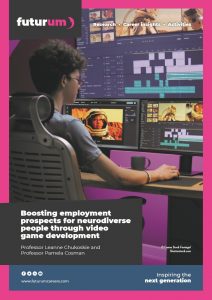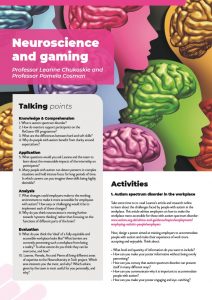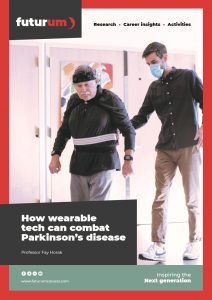Boosting employment prospects for neurodiverse people through video game development
Despite often having the potential to be huge assets to the workforce, people with Autism Spectrum Disorder often face discrimination and have difficulties obtaining and maintaining jobs. Professor Leanne Chukoskie, from Northeastern University, and Professor Pamela Cosman, from the University of California San Diego, in the US, are combatting this through a unique internship that champions the skills of neurodiverse interns and trains them how to negotiate the workplace.
Glossary
Autism/autism spectrum disorder — a developmental condition that typically involves impaired social communication and repetitive and restricted patterns of behaviour. Autism exists on a spectrum, meaning that different individuals with autism often present very different behaviours
Internship — a period of work placement where a trainee gains experience of a specific job role or industry
Masking — in psychological terms, when a person conceals their natural personality to better conform with social pressures
Neurodiverse — a term used to describe the different ways in which people’s brains work
Neurotypical — a term used to describe people whose brains function in a way considered typical by the wider population
People with autism often find it difficult to integrate into the working world, facing challenges that neurotypical people might not even consider. Professor Leanne Chukoskie specialises in the intersection between neuroscience and game design and development and leads a pioneering internship at Northeastern University that aims to help people with autism spectrum disorder build their skills and access exciting opportunities in the workforce. She began this internship in 2018 with a grant from the San Diego Foundation. Leanne and her colleague Professor Pamela Cosman, who now leads the University of California San Diego internship, won a four-year NSF grant to further develop the internship and related tools to help neurodiverse employees in tech..
Battling preconceptions
“Whether consciously or not, employers often prefer individuals who display polished social skills,” says Leanne. “As this is an area where autistic individuals often have challenges, they can fare less well in interviews.” There is also a misconception that accommodating neurodiverse individuals can be expensive or time-consuming, but Leanne says this is rarely the case. “Frequently, flexibilities offered to all employees accommodate autistic individuals effectively,” she says.
Despite these prejudices, individuals with autism often have skills that can be highly useful to the working world. “The autism spectrum is broad, but there are certain peaks and challenges in ability,” says Leanne. “Some of these peaks are the ability to detect patterns in complex situations and to be able to hold intense focus for long periods of time.” Although these are highly desirable traits for most jobs, securing employment can be challenging for people with autism – and employers lose out as a result of this.
Challenges in the workplace
Workplaces can have complex social rules that are rarely communicated directly. “Interpreting these rules can be quite challenging for autistic people,” says Leanne. “Clarity with expectations and direct communication benefit employees with autism.” Pamela points out that such clarity can actually be advantageous for all employees, helping to avoid misunderstandings or miscommunications. “For example, a manager spelling out the expected length and content of a report can be a lot more helpful than just asking for a ‘progress report’ with unclear parameters,” she explains.
Many autistic individuals recognise that these workplace norms exist and work hard to comply with them. “This effort to fit in – called masking – can be exhausting,” says Leanne. “It’s like having an additional large task assigned to you every day.” While neurotypical people might easily understand these norms – for instance around punctuality, appropriate clothing, playing music while working, or phone use during working hours – it can take conscious effort for neurodivergent individuals to detect and follow these unwritten rules. Leanne’s team is piloting some tools that could make this process less draining – for instance, one subtly helps users to orient themselves better in meetings to demonstrate they are paying attention.
NeuroDiversity in Tech Internship
The NeuroDiversity in Tech internship began life at the University of California San Diego, led by Pamela, and has since expanded to the Rehabilitation Games and Extended Reality (ReGame-XR) Lab at Northeastern University, which Leanne leads. “The internship involves nine weeks of teamwork, with participants taking the roles of programmers, project managers, artists and designers,” says Leanne. “All have the aid of a peer coach to collectively develop an educational or research-based video game.” Prospective interns are chosen and allocated roles using written responses to questions around interests and experience in game design, as well as online interviews for which questions are sent in advance.
Mentoring opportunities form a key part of the internship. “Our coaches are trained to offer feedback, not only in aspects of game development but also in workplace norms and effective collaboration,” explains Leanne. “They work closely with interns to support their individual needs.” The internship can be intense at times, involving periods of stress as deadlines approach, but this challenge can help drive teamwork and provide experience of real-world workplace pressures.
Skills and successes
Reference
https://doi.org/10.33424/FUTURUM488
The internship imparts a mixture of hard and soft skills. “Hard skills involve learning how to use the Unity game engine, synchronising animations with sound, and quality assurance testing,” says Leanne. “Soft skills involve clear communication, effective teamwork, mutual support, and contributing to the kind of workplace they want to work in.”
This combination of skills helps interns develop their game project and contributes to their employment prospects down the line. “We see a lot of growth in our interns over the nine weeks,” says Leanne. “We get especially excited when interns tell us that they won a competitive job after the internship.” The internships also double up as valuable networking opportunities. Clients provide projects and work with interns, and the end-of-project showcase event introduces the interns’ talents and commitment to the wider tech community.
Now, Leanne and Pamela hope to increase the support they can offer to interns. “We are seeking funding to extend the programme, so interns can build even more skills and get more projects on their portfolios,” says Leanne. “We would love for this to dovetail with our own research, so that interns can go beyond design and development and get involved in the science behind the games.”
 Professor Leanne Chukoskie, PhD
Professor Leanne Chukoskie, PhD
Associate Professor, Department of Physical Therapy, Movement and Rehabilitation Science, Bouvé College of Health Sciences, Games Program, College of Art, Media and Design, Northeastern University, USA
Fields of research: Neuroscience, game design and development
Funder: US National Science Foundation (NSF): Future of Work at the Human-Technology Frontier
Professor Pamela Cosman, PhD
Distinguished Professor, Department of Electrical and Computer Engineering, Jacobs School of Engineering, University of California, San Diego, USA
Field of research: Electrical engineering
Funders: US National Science Foundation (NSF), Motorola Solutions Foundation, Foundation for Developmental Disabilities
About neuroscience
Neuroscience is the study of the body’s nervous system, often focusing on the brain. Neuroscientists might study specific functions, mechanisms, developmental pathways and diseases of the nervous system. This includes holistic approaches that closely examine the link between the nervous system and our interactions with the world around us. Leanne explains more about her field:
“My work involves a lot of collaboration. In particular, I work with computer scientists, computer engineers and electrical engineers. Together, we can make better sense of the data collected using machine algorithms.
“The human brain is vastly complex. We are entering a stage of research where we are thinking less about the function of a particular area of the brain and more about how the system functions as a whole. This approach is giving us new ways to leverage the combination of brain imaging and behaviour.
“Research tools are becoming ever more sophisticated. We now have better tools to examine how two people’s brains are synchronised when they are working well together. The concept of interpersonal synchrony demands a lot of interesting computation on top of the brain and behavioural data collection but gets us much closer to understanding how the brain functions during everyday interactions.”
Pathway from school to neuroscience
Leanne emphasises that data analytics skills are becoming increasingly essential in neuroscience. This involves skills in mathematics, statistics and computer science, in addition to a strong biological underpinning.
At school and beyond, useful subjects include mathematics, statistics, biology, computer science and physics.
Undergraduate courses or modules that can lead to a career in neuroscience include biology, neuroscience, molecular biology, biochemistry and psychology.
Explore careers in neuroscience
Northeastern University’s Center for STEM Education offers a wide range of ways for young people to get involved in STEM projects, including summer schools, field trips and lab experience.
Northeastern University has co-designed summer job opportunities for low-income youth in the area, which includes work experience in a wide array of disciplines.
The National Institute of Neurological Disorders and Stroke (NINDS) runs summer internship programmes for high school students to get involved in neuroscience research.
According to Glassdoor, the average salary for a neuroscience researcher in the US is $97,000 per year.
Meet Leanne
Growing up, I wasn’t exposed to research in any way, so never considered research-focused careers. But I was always fascinated in why people thought, interacted and solved problems the way they do. This led me to the idea of becoming a psychiatrist, which sounded like a good fit for my early interests.
My excitement for research came from a work-study job in my first year in an infant virology lab. We were seeking to understand the causes of infant diarrhoea, which might sound disgusting, but was actually really exciting – every day you could discover something new that others hadn’t seen before. I also loved the camaraderie in the lab and how senior students supported junior students’ development. This experience was foundational in my path to becoming a researcher.
I had a strange path to my current position. My PhD and early postdoctoral research were in systems neuroscience, but I realised that I wanted to focus more on studying questions impacting the human condition. At the time, a family member was diagnosed with autism spectrum disorder, and the questions around the best approach to caring for this child redirected my career toward autism research.
I attended the talk of a well-respected researcher and, boldly, approached him afterwards. I told him I had applied to his programme on autism, and that I didn’t have much experience in autism but could contribute my systems neuroscience skills and a deep willingness to learn. My acceptance to the programme followed, and it changed the course of my career.
I then worked in autism-related research initiatives for over ten years. One research project involved a clinical trial for gaze-driven games for attention training, which could help some neurodivergent people. I have also been granted ‘start-up’ funds to create sensor-enabled games for research, which we called the Power of NeuroGaming (PoNG) Center. The existence of PoNG made the ReGame- XR internship possible.
Looking forward, I am keen to focus more on social neuroscience. This involves looking at how the brain and people’s behaviour change when people interact with each other. New behavioural and neural signal measurement tools are making these kinds of measurements more feasible. This is the kind of thing that makes up our everyday conscious experiences, yet we know remarkably little about it.
Leanne’s top tips
1. Get involved in research early on and find a mentor willing to guide you. It doesn’t even matter what sort of research it is – mine was baby poop! It’s more about learning the process and the skills involved, which will be useful regardless of the topic.
2. Take a ‘multiple lenses’ approach to a problem. Try to see a problem from different perspectives and different levels of analysis, which helps to consider a problem in a new and unique way.
Meet Pamela
As a kid, I loved building things like toy cities and marble machines. My dad was an electrical engineer and introduced me to coding when I was about six. But I also loved reading, writing and medicine, so it was hard to narrow down what I wanted to do! In the end, I chose engineering because of that joy of building things, but I’ve also been able to bring medical and creative writing aspects into my work.
During my education, I have had both awful and truly great professors and advisors. Such polar opposites helped show me that I could be a good teacher and mentor. My proudest career achievements involve my students, both the doctoral students who do research with me and the undergraduates in my courses. It makes me very happy when someone tells me that one of my classes inspired them to go into teaching, or when a former doctoral student got dozens of patents for her inventions. I am also very proud when something I create gets used in the real world.
My current research explores point clouds. These are huge data sets of points in 3D space, which can represent detailed scene and object information. For example, self-driving cars use them to know where things are around them. I find the practicality of my research rewarding, and I love that I’m constantly learning something new. One year I’m involved in a project of colour restoration for underwater images, and the next, helping to make a home guidance system for physical therapy.
In the future, people will have all kinds of electromechanical devices within their bodies. These can help enhance our capabilities and our lifespan. Virtual reality and augmented reality will be part of everything, and electrical engineers will be designing those systems. Plus, the next generation of engineers will be working on a lunar station, an asteroid station and, eventually, a Mars station – with all sorts of exciting electrical devices!
I’ve written several fiction books for kids. They introduce engineering and mathematics topics through fiction – who knew that error correction coding could help defuse a hostage crisis, for instance? I aim to write more, and the third book in the series should come out in 2024.
Pamela’s top tip
Think of setbacks or failures as opportunities to learn and grow, not as reasons to give up. Some people are overly shielded from setbacks, so when they do encounter one, they think it’s a sign they don’t belong or they shouldn’t be working on that project. Resilience and perseverance are important – embrace it when something doesn’t go exactly right!
Meet Ara

Ara Jung
Administrative Researcher, ReGame-XR Lab, Department of Physical Therapy, Movement, and Rehabilitation Sciences, Bouvé College of Health Sciences, Northeastern University, USA
Field of research: User experience research
My background is in psychology. This stemmed from my fascination with the uniqueness of people’s experiences during shared events. Although I‘ve always enjoyed gaming, I never considered it as a potential career path – until I discovered roles related to games’ user experience and research, and I realised my two passions could converge into a meaningful career.
The ReGame-XR lab stood out to me. It harnesses games as virtual environments for research, allowing the capture of biometric data such as gaze or heart rate, which is challenging in a physical setting. I joined the lab, eager to contribute to this innovative intersection of psychology and gaming as a games user experience researcher. I also work as a lab administrative researcher and coordinate the lab’s summer internship programme.
An ‘epiphany moment’ for me was realising the immense flexibility in career options. The rising demand for utilising games as learning tools across diverse fields would allow me to apply creative design skills and collaborate with experts from academia and medicine.
I lead the coaching element of the summer internship. Our coaching focuses on both hard and soft skills. We provide feedback not only on the quality of their work but also on improving communication and assisting participants in expressing their needs and intentions more clearly. We believe in modelling the behaviour we expect from participants, including fostering an environment where they feel comfortable sharing feedback with us.
I love witnessing tangible improvements in people’s experiences through the iterative process of our projects. In my role as a researcher, conducting usability studies and identifying pain points has allowed us to enhance the quality of our data. As a coordinator, I love seeing our students and interns have a wonderful experience. Our interns report a significant increase in their confidence when seeking employment and a heightened belief in their ability to excel in a workplace.
For the future, I aim to build a process where user experience and research can be seamlessly embedded into scientific rigour. The combination of user experience and research and academic science is relatively new, but I believe the integration of user experience and research into the development of scientific tools and software can enhance the quality of research.
Ara’s top tip
Network! Building connections is crucial in the games industry. Join online communities, share your thoughts, ask questions and consider attending real-world conferences and events. See networking not as a chore but an opportunity to genuinely engage with people, show interest in their work, and build meaningful relationships.
Meet Pierre

Pierre Escaich
Neurodiversity Talent Program Director, Ubisoft, Sweden
Field of research: Neurodiversity
Working at Ubisoft is my first job – I’ve worked here for 25 years now! Video games became a passion for me because of the atypical creativity you find among its developers and players.
As Ubisoft’s Neurodiversity Talent Program Director, my aim is to empower current and future neurodiverse employees by bringing them the support they need to realise their full potential at work.
Neurodiverse people bring a huge amount of skills to the gaming industry. These are skills that we need to develop innovative games: from high 3D visualisation skills to fine detail processing; from the ability to see the big picture to the ability to hyperfocus. We need to constantly think outside of the box to create fun games.
The power of neurodiversity can be unlocked by adapting the work environment, so people can express and develop their talents and skills, while being respectful of everyone’s individuality. It requires a skills-focused approach to management, bringing psychological safety to teams and actively valuing different ways of thinking, communication and problem solving.
Ubisoft supports the ReGame-XR Lab because we are keen to encourage original initiatives that focus on promoting video game development among communities that are passionate but might feel excluded from the job market. Neurodivergent individuals have a lower access to the job market, despite their talents and skills.
We provide mentoring to the ReGame-XR Lab participants, sharing practical tips of how to experiment with and work through game prototyping. We also give advice about the recruitment process in the industry.
Supporting ReGame-XR Lab brings us great pride and motivates us to keep promoting both neurodiversity and video game development. All our mentors have a neurodiverse background and are passionate professionals. They are keen to share their knowledge with their peers and to show that you can be neurodiverse and pursue a meaningful career in the video gaming industry.
I am particularly proud of the collective achievement of having launched a dedicated neurodiversity initiative within Ubisoft, with an employee resource group of 500+ members across the world and a dedicated human resources talent programme to promote neuroinclusive good practices.
Ubisoft’s goal is to be recognised as a leader in neuroinclusion at work. We hope to inspire others by providing trainings, tools and awareness of what neurodivergent people can contribute to industry.
Pierre’s top tips
1. Follow your passion.
2. Try, fail and try again – that is how we develop video games.
3. The video game industry needs all types of minds to develop enriching and innovative games. If you identify as neurodiverse, know you have a part to play in creating fun games.
Pathway from school to the game industry
Ara emphasises the huge range of disciplines involved in the game industry and how important it is to learn about these disciplines so you can see what overlaps with your own interests.
Study the job postings for these positions to note what kind of skills and experience employers are looking for.
Ara advises, “Search through the International Game Developers Association’s Special Interest Groups (igda.org/sigs) to join a group with people in the industry who share the same passion and values as you.”
She also recommends joining the Games User Experience and Research Special Interest Group to gain insights into the vital role of user experience and research in creating successful games.
Do you have a question for Leanne, Pamela, Ara or Pierre?
Write it in the comments box below and Leanne, Pamela, Ara or Pierre will get back to you. (Remember, researchers are very busy people, so you may have to wait a few days.)
2 Comments
Submit a Comment
Learn more about research conducted by a neuroscientist:
www.futurumcareers.com/how-wearable-tech-can-combat-parkinsons-disease










Hello. You have great information. My son is a college student with 60 or more credits into his major: video production & emerging media. He is facing challenges with internships opportunities. We’re both neurodivergent and Im advocating for my son. What can I do to help? Are there opportunities outside of Oregon that he should be looking at?
Hi Jaclyn, Thank you for reaching out! Your son is fortunate to have you advocating for him. There are not very many neurodiversity-specific internship programs, but there are still some opportunities. Perhaps you can look into https://exceptional-minds.org/ ? I typically recommend that young job-seekers practice requesting and asking questions for an informational interview. Once ready, identify a few people who have jobs that are interesting to your son and reach out. Most people will schedule a 20-30 minute call with an early career job-seeker who expresses interest in what they do. These actions open doors and help connect folks with opportunities that may not otherwise be obvious. I wish you and your son the best of luck!